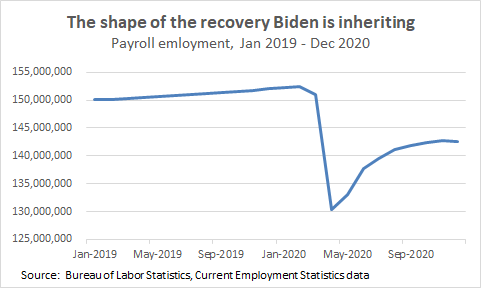Here we are, astonishingly, at the first #JobsDay of 2021. As we are all taking stock of where things stand in our democracy, it’s a moment to also take stock of where things stand in the labor market, after 2020. Brace yourselves. 1/
After months of slowing gains, we lost 140,000 jobs in December as the virus surged. The labor market is in turmoil. We have nearly 10 million fewer jobs than we did 10 months ago. 2/
Further, in the year before the recession, we added 194,000 jobs per month on average, so from February to December, we could have added around 1.9 million jobs. That means the total gap in the labor market right now is on the order of 11.8 million jobs. 3/
Another grim finding is that we are down 1.4 million state and local government jobs over the last 10 months—most of it (more than 1.0 million) in education. THIS IS A MINDBOGGLING UNFORCED ERROR. Fortunately, given the new senate, Congress can pass aid to state & local govts. 5/
At 6.7%, the unemployment rate remains in recessionary territory (it’s higher than the unemployment rate ever got in the early 2000s downturn). Further, the unemployment rate is not counting all coronavirus-related job losses. 6/
In December there were 10.7 million workers who were officially unemployed. But there were an additional 1.0 million workers who were temporarily unemployed but who were being misclassified as “employed not a work.” 7/
Further, the total number of workers who were out of work as a result of the virus but were being counted as out of the labor force instead of as unemployed because they weren’t actively seeking work was 5 million. 8/
And there are at least another 2.7 million who are unemployed but are not being counted as unemployed because CPS survey nonresponse is nonrandom, and nonresponders are more likely than the general population to be unemployed. 9/
That’s 19.4 million workers who were either unemployed or otherwise out of work as a result of the virus in December. If all these workers were taken into account, the unemployment rate would have been 11.4% in December. 10/
There are also 7.5 million workers who are employed but have seen a drop in hours and pay as a result of the virus in December—a large increase from November. 11/ https://www.bls.gov/web/empsit/covid19-table5.xlsx
So altogether, 19.4 million workers are either unemployed or otherwise out of work because of the virus, and another 7.5 million are employed but have seen a drop in hours and pay, for a total of 26.9 million workers directly hurt by the COVID recession. 12/
That is 15.8% of the workforce—and it doesn’t count those who lost a job or hours earlier in the pandemic but are back to work now. The cumulative count of those harmed would be much greater. 13/
The 26.9 million also ignores the fact that even workers who are employed and haven't had their hours cut are hurt by the crisis. When job openings are scarce, workers’ leverage dissolves. Employers don’t have to pay as well when they know workers don’t have outside options. 14/
And a reminder that it is not true that "everyone" is working from home because of the pandemic—only 23.7% of employed people report having teleworked or worked at home in the last 4 weeks because of the pandemic. That's less than one in four workers! 15/ https://www.bls.gov/web/empsit/covid19-table1.xlsx

 Read on Twitter
Read on Twitter


